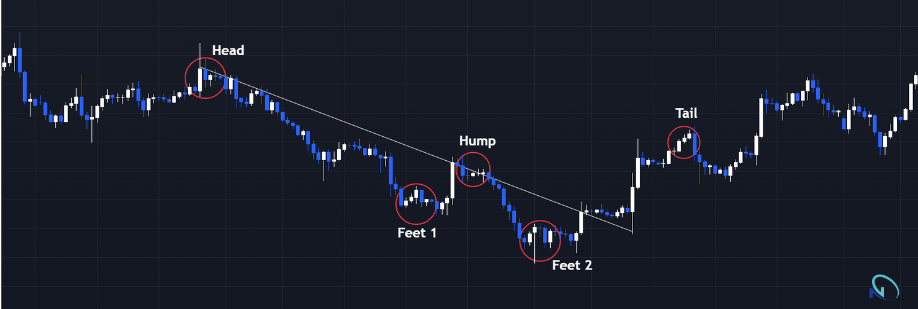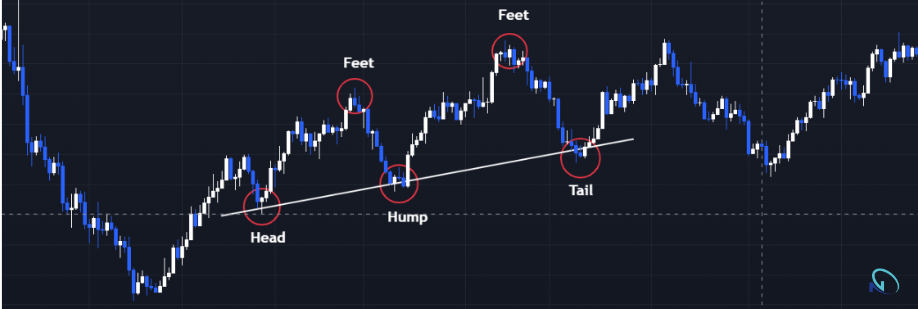It's like the forgotten sibling of the dragonfly candlestick, living in the shadows of market strategies. Not many folks give it the attention it deserves, probably because it's not the popular kid in the trading block. But, hey, if you squint your eyes and peek into the market playground, this quirky pattern might surprise you. It's got names that sound like bedtime stories for kids, but trust me, it's no child's play. Watching the market dragon dance is like trying to herd cats – not easy, but oh-so-interesting! And, these patterns, represented by a distinctive "W" or "M" shape, indicate an imminent price reversal in the market. So, buckle up and take flight with the dragon because, who knows, there might just be a pot of profit gold at the end of this whimsical rainbow!
Components of a Dragon Pattern:1. Head: The head signifies the prior trend, serving as the starting point of the dragon pattern. A bullish dragon emerges after a bearish trend, while a bearish dragon forms above a preceding bullish trend.
2. Feet: Two feet, strategically positioned with the second slightly below the first, play a crucial role. A larger second foot often signals a more substantial market reversal. For bearish dragons, the feet are inverted.
3. Hump: A subtle rise between the dragon's feet, the hump is above the feet of a bullish dragon and below for a bearish one.
4. Tail: The tail marks the point of breakout, triggering either a bullish or bearish market sentiment. A bullish breakout leads to rising prices and a dominance of buyers, while a bearish breakout results in falling prices with sellers taking control.
Types of Dragons:
Bullish Dragon Pattern:

1. Resembles the letter "W."
2. Prior trend: Bearish.
3. Market breakout: Bullish breakout.
4. Forecast: Buyers take over the market.
Bearish Dragon Pattern:

1. Resembles the letter "M."
2. Prior trend: Bullish.
3.Market breakout: Bearish breakout.
4. Forecast: Sellers dominate the market.
Trading Strategies:
Bullish Setup:
Entry:
- Confirm after the formation of the second foot.
- Draw a trend line through the head, hump, and the point after the second foot for the ideal entry point.
Take Profit:
- Short trade: Profit above the tail, equivalent to the head, or the hump.
- Long trade: Wait for a significant breakout spike.
Risk Management:
- Place a stop loss below the second foot to protect potential losses.
Bearish Setup:
Entry:
- Enter below the second foot.
- Draw a trend line from the head, crossing the hump, and identifying a significant entry point.
Take Profit:
- Short trade: Profit using a parallel line to the head.
- Long trade: Wait for a bearish breakout before taking profits.
Risk Management:
- Place a stop loss above the first foot to minimize potential losses.
Alternate Trading Strategy:
Utilize the dragon pattern's similarities to the double top/bottom patterns, incorporating tools such as trend lines, MACD, support/resistance zones, and Fibonacci retracement levels.
Success Ratio:
When approached with the right technical analysis and tools, dragon pattern trading boasts a success ratio that can exceed 80%.
Conclusion:
In conclusion, the dragon pattern is a rare yet reliable phenomenon in trading. Recognizing and utilizing this pattern requires skill and precision. To enhance your trading experience, consider combining the dragon pattern with other technical indicators and tools. Success in trading lies in the careful confluence of these elements with the mythical dragon pattern. May your trading endeavors be prosperous and filled with positive surprises! Happy trading!


